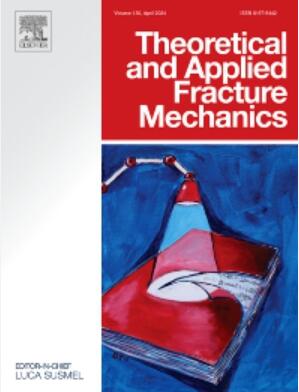基于lcz的r曲线黏结区模型模拟层合复合材料i模和混合模弯曲下分层扩展
IF 5.6
2区 工程技术
Q1 ENGINEERING, MECHANICAL
引用次数: 0
摘要
为了准确预测复合材料结构的脱层行为,必须考虑断裂过程区(FPZ)中纤维桥接等增韧机制。在本研究中,研究了光纤桥接(r曲线)与相应FPZ之间的关系。在研究复合材料的纤维桥接行为时,考虑了结构尺寸、堆叠顺序和载荷。我们提出了一个r曲线表达式来估计任意构型的结构在ⅰ型和混合模态加载下沿FPZ的断裂韧性变化。这些表达式被纳入到简单的双线性软化定律中,以模拟任何结构构型在不同荷载条件下的分层行为。所提出的方法计算效率高,只需简单的实验测量,例如初始和稳态断裂韧性值。这消除了传统黏聚区模型在模拟层合复合材料结构的大规模桥接行为时所面临的挑战。在i型加载条件下,对不同厚度和交叉层数的试样进行了验证。通过对混合模态弯曲试件进行不同模态比的加载,研究了加载的影响。结果表明,预测值与实测值基本吻合。本文章由计算机程序翻译,如有差异,请以英文原文为准。
Simulation of delamination propagation in laminated composites under Mode-I and Mixed-Mode bending with LCZ-Based R-curve cohesive zone modeling
For accurate prediction of the delamination behavior in the case of composite structures, toughening mechanisms like fiber bridging occurring in the fracture process zone (FPZ) must be considered. In this study, the relationship between the fiber bridging (R-curve) and the corresponding FPZ was investigated. Structural size, stacking sequence, and loading were considered in the study of the fiber-bridging behavior of composites. We propose an R-curve expression to estimate the variation of fracture toughness along the FPZ for structures of any configuration under mode-I and mixed-mode loading. These expressions are incorporated into simple bilinear softening laws to model the delamination behavior of any structural configuration under different loading conditions. The proposed methodology is computationally efficient, requiring simple measurements from experiments, such as initial and steady-state fracture toughness values. This eliminates the challenges of the conventional cohesive zone model in modeling large-scale bridging behavior in laminated composite structures. The proposed method was validated for different specimen configurations with variable thickness and cross-ply under mode-I loading. The effect of loading was investigated by subjecting a mixed-mode bending specimen to different mode ratios. The results indicated that the predicted values are in reasonable agreement with the measured values.
求助全文
通过发布文献求助,成功后即可免费获取论文全文。
去求助
来源期刊

Theoretical and Applied Fracture Mechanics
工程技术-工程:机械
CiteScore
8.40
自引率
18.90%
发文量
435
审稿时长
37 days
期刊介绍:
Theoretical and Applied Fracture Mechanics'' aims & scopes have been re-designed to cover both the theoretical, applied, and numerical aspects associated with those cracking related phenomena taking place, at a micro-, meso-, and macroscopic level, in materials/components/structures of any kind.
The journal aims to cover the cracking/mechanical behaviour of materials/components/structures in those situations involving both time-independent and time-dependent system of external forces/moments (such as, for instance, quasi-static, impulsive, impact, blasting, creep, contact, and fatigue loading). Since, under the above circumstances, the mechanical behaviour of cracked materials/components/structures is also affected by the environmental conditions, the journal would consider also those theoretical/experimental research works investigating the effect of external variables such as, for instance, the effect of corrosive environments as well as of high/low-temperature.
 求助内容:
求助内容: 应助结果提醒方式:
应助结果提醒方式:


